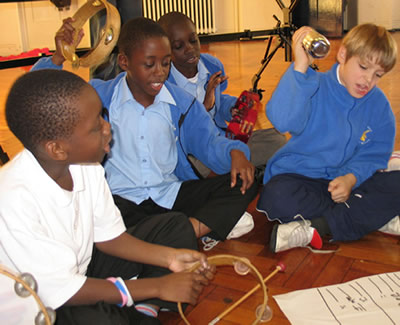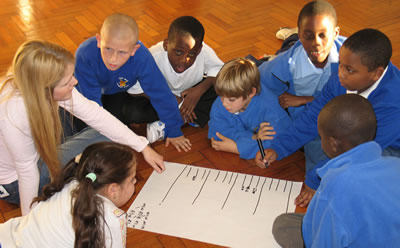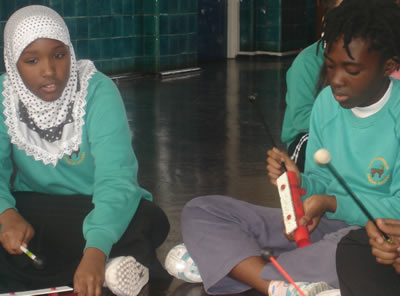Or search by topic
Number and algebra
Geometry and measure
Probability and statistics
Working mathematically
Advanced mathematics
For younger learners
Published 2006 Revised 2008
Count the Beat
Can music-making help your pupils understand mathematical concepts such as fractions, ratios and probability? In autumn 2005, creative arts charity, Create, sent four professional musicians to maths classrooms to find out. In this article, Create's founders - Nicky Goulder and Samantha Lodge - reveal how maths books and marimbas can go hand-in-hand.
Introduction
If you're a maths teacher, the thought of thirty children all playing tambourines and bongo drums may not immediately appeal, but does music-making have the potential to help your pupils understand mathematical concepts such as fractions, ratios and probability? Eager to explore this possibility, Create launched its pioneering cross-curricular maths and music project, Count the Beat, in October 2005. This involved four of Create's leading professional musicians taking music and maths workshops to 150 pupils (aged 9 to 11) at two primary schools in South East London.
Project Background

The motivation behind every Create project is to give individuals a chance to be creative, develop valuable life skills (such as teamwork, listening and communication), become more confident and have fun! Since its foundation in July 2003, Create has run a great number of music projects in schools across the UK and, when you run as many music projects as Create, the parallels between maths and music are never far from your mind. Beats in a bar, for instance, translate into fractions, note lengths into ratios and symmetry is used to create harmonies and texture. The more music projects we ran, the more we thought about how we could consciously draw out these parallels and use music-making as a tool to aid teachers to communicate key mathematical principles.
We were further inspired by Dr Gordon Shaw's seminal 1999 study that identified a causal relationship between musical training and improved numerical ability. Taking place in Los Angeles, the study compared the maths test results of children who had been given piano lessons with those who had received traditional maths teaching assisted by the use of computer programs. Dr Shaw found that pupils who had piano lessons saw a significant improvement in their maths skills - particularly with regards to ratios and fractions . For Dr Shaw, this served to highlight the connection between pupils' music-making and their grasp of mathematical principles: "The learning of music emphasises thinking in space and time ... when children learn rhythm, they are learning ratios, fractions and proportion" (Dr Shaw, Neurological Research, 1999).
It was funding from Citigroup Foundation that finally allowed us to put our plans to take musicians into maths classrooms in motion and, in 2005, Count the Beat was born.
The Project
We embarked upon this project with two main aims: to help teachers deliver the Maths Curriculum in fun and imaginative ways; and to introduce children to the creative potential of maths. Our overall vision was to achieve a sense of seamless learning by bringing together supposedly separate areas of the curriculum. Activities began on 4 October 2005, when we took a team of four musicians to Key Stage 2 pupils at Lewisham Bridge School and Lucas Vale Primary School. It was a new area for us all, so we couldn't wait to see what the children and teachers would make of it!
Each session started with the class teacher delivering a brief lesson on a key mathematical principle, such as fractions, angles, ratios, measurement or probability. The rest of the session was spent bringing these principles to life through a range of creative music activities.
"Practical application of any theory is always good to reinforce an idea. Using music to teach maths is excellent both for maths and music ... the maths comes alive and the composition of music is more clearly understood." (Create musician)

A workshop that had children transforming fractions upon a number line into a musical score was particularly effective in highlighting the connection between these two disciplines. Leading on from the teacher's lesson on fractions, the musicians asked the class to create a number line of twenty units. They then divided the class into small groups, giving each group a different instrument to play. One group, for example, had xylophones, another had African djembe drums. Each group was then given three fractions that they had to plot on a number line. Once they had completed this task, one of the musicians began to clap a steady beat and asked the first group to beat their instruments when their fraction came up. To illustrate, let's say that this group had been given the fractions $\frac{2}{10}$, $\frac{3}{4}$ and $\frac{4}{5}$. This would mean that they would hit their given instruments on the 4th, 15th and 16th beats. After each group had practised playing their fractions on their own, the musicians helped the children to bring these different rhythms together to create a class musical score.

"By counting rhythm and learning the timing of beats, we have really seen an improvement in the pupils' mathematical ability ... the kids have loved this creative way of learning!" (Deputy Head of Lewisham Bridge School, Julia Holmes, speaking on behalf of the school's educators)

Summing Up
"The gains from this project have been wide reaching, from improved retention of mathematical vocabulary to increased self confidence, from a greater understanding of rhythm to a greater understanding of fractions, from an improvement in listening skills to greater knowledge of musical instruments. It is hard to separate the musical gains from the mathematical gains, but isn't that what learning should look like, seamless?" (Head of Lewisham Bridge School, Sue Sarna, and Head of Lucas Vale Primary School, Alexandra Hardy)
The first year of Count the Beat was a fantastic experience and our musicians are looking forward to building on the project's successes when we return to Lewisham Bridge and Lucas Vale schools in the autumn and spring terms of this new academic year.
Inspired?
If you feel inspired by this article, why don't you try out some of the Count the Beat activities described above in your own maths classroom!
Whilst a team of professional musicians and an extensive collection of percussion instruments are, of course, a big bonus, both the number line/musical score activity and the probability exercise can be adapted to your own maths classroom. Pencils can be drummed on table-tops for instance and yogurt pots can be filled with rice to make maracas.
With the number line activity, you might want to start by getting the children to create a simple number line of twenty units (you can make it harder once they've got the hang of it!). Then divide the class into three groups and give them each a simple set of fractions (for example one group could have $\frac{1}{2}$, $\frac{3}{10}$, $\frac{1}{5}$, another $\frac{1}{4}$, $\frac{2}{5}$, $\frac{8}{10}$ and the last $\frac{19}{20}$, 1, $\frac{3}{5}$). You don't need to worry if it doesn't make a great rhythm at first; in fact that could be worked into the exercise. You could then get them working in small groups to plot fractions that make a rhythm they like better.
Good luck!!
For more inspiration, visit www.createarts.org.uk

